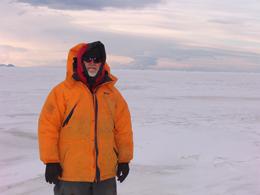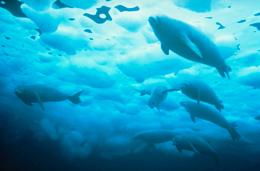What lies beneath Antarctic ice?
Rodolfo del Valle and his team are heading to the Southern Ocean to measure a methane leak.
 For three years, Rodolfo del Valle and his team will be probing the ice and seabed in the Erebus and Terror Gulf.
For three years, Rodolfo del Valle and his team will be probing the ice and seabed in the Erebus and Terror Gulf.Persistent bubbling is stirring the water's surface in the Erebus and Terror Gulf, a remote spot off the Antarctic Peninsula. When he saw the commotion in 2000, Argentinian geologist Rodolfo del Valle was intrigued — despite 38 years' experience in the region. There was a chance the gas contained methane, and when del Valle's team investigated the leak they discovered it to be 99% methane.
This is bad news. The gas is not only 25 times more powerful than carbon dioxide at heating the atmosphere; methane hydrates locked up in the Antarctic seabed and ice also contain vast amounts of carbon — overall, methane deposits contain about half of global carbon. With a recorded decline in Antarctic ice shelves, the long-term effect of deteriorating and melting ice could range from boosting global warming to helping trigger mass extinctions. Nature caught up with del Valle on the eve of his departure for the first on-the-ground study to quantify methane leakage in shallow waters and ice in the Gulf.
What's the overall rationale for your upcoming three-year focus on methane hydrate deposits?
Statistics and figures aside, I have been participating in Antarctic expeditions for so long that I've seen entire ice shelves crumble into pieces small enough to prepare a Scotch on the rocks. We have had to redraw maps. Global warming is a fact, and once we quantify methane emissions we will have scientific proof that the substrate on the seabed is melting and leaking methane. If these methane deposits reach the atmosphere, they will deepen the greenhouse effect, which, in turn, will promote further methane release, thus closing the circle and ramping up warming.
A number of studies have pointed to methane as a factor in mass extinctions. Are we looking at the start of a similar scenario now?
By quantifying the emissions and establishing their magnitude, we will be able to begin to determine how they will affect global warming. We believe there is a huge amount of destabilized methane deposits that may leak into the atmosphere and ramp up warming. This is not a new fact in geological history. Of seven major mass extinctions that erased 90% of the species at the time, five are attributable to climate change, and one in particular — at the Permo-Triassic boundary — could be directly attributable to mass methane release in the Upper Palaeozoic.
 Methane could be implicated in deaths of crabeater seals in the area.Doug Allan / Nature Picture Library
Methane could be implicated in deaths of crabeater seals in the area.Doug Allan / Nature Picture LibraryWill you be investigating any direct consequences of methane leakage around the northern Antarctic peninsula?
The British Falkland Islands Dependencies Aerial Survey Expedition findings from the mid-1950s showed unusual numbers of crabeater seals dying in this area. Members of the expedition suggested that methane could be implicated. During the calving season, seals live and give birth on top of the frozen layer of sea, and dive for food through holes in the ice. One theory is that methane accumulates under the marine ice and escapes through cracks during low tides. The methane deposits located below the ice then expand. These emissions would be responsible for the massive death of seals: methane is usually accompanied by hydrogen sulphide, a toxic metabolite of methanogenic bacteria at the seabed. So we'll be looking at that in connection with the seal deaths.
Your investigation will focus on marine ice and shallow waters. Why shallow?
Working in waters less than 50 metres deep means seabed core samples are still frozen when they arrive at the sea surface for transport back to the lab for analysis. With frozen samples, we can determine the methane content of each ice layer. By looking at the ice crystals' structure, we can see possible freezing and thawing patterns of ice through ages. With crystals containing methane, we can tell how and when climatic variations occurred and their correlation with methane concentrations. All this will contribute to our knowledge of the nature of these deposits and the long-term climate change timeline through geological eras.
Over the three years we're here, we will be able to monitor gases, determine the amounts escaping into the atmosphere during the seasons and ascertain any correlation with certain meteorological parameters such as pressure, winds and temperature to determine whether it's a massive escape — in which case effects on climate are far more likely.
Given the extreme weather conditions in Antarctica, how will your team coordinate the research in summer and winter?
Over the winters we will work on the ice shelf until the warm season arrives, when ice begins to fragment and is no longer safe to work on. At that moment, we will return to Argentina to analyse the information gathered in winter and prepare ourselves to return to work in summer, this time in expeditions on the water, when we'll collect gas samples from boats and explore the area with probes to locate the leaks.
Link: http://www.nature.com/news/2010/100903/full/news.2010.442.html







No comments:
Post a Comment